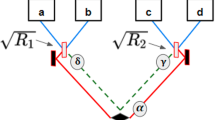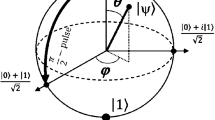Abstract
Signal causality, the prohibition of superluminal information transmission, is the fundamental property shared by quantum measurement theory and relativity, and it is the key to understanding the connection between nonlocal measurement effects and elementary interactions. To prevent those effects from transmitting information between the generating and observing process, they must be induced by the kinds of entangling interactions that constitute measurements, as implied in the Projection Postulate. They must also be nondeterministic as reflected in the Born Probability Rule. The nondeterminism of entanglement-generating processes explains why the relevant types of information cannot be instantiated in elementary systems, and why the sequencing of nonlocal effects is, in principle, unobservable. This perspective suggests a simple hypothesis about nonlocal transfers of amplitude during entangling interactions, which yields straightforward experimental consequences.
Similar content being viewed by others
References
Peskin, M.E., Schroeder, D.V.: An Introduction to Quantum Field Theory. Addison-Wesley, Reading (1995)
Bell, J.S.: On the Einstein-Podolsky-Rosen paradox. Physics 1, 195 (1964)
Bell, J.S.: On the problem of hidden variables in quantum mechanics. Rev. Mod. Phys. 38, 447–452 (1966)
Aspect, A., Grangier, P., Roger, G.: Experimental realization of Einstein-Podolsky-Rosen-Bohm gedankenexperiment: a new violation of Bell’s inequalities. Phys. Rev. Lett. 49, 91 (1982)
Aspect, A., Dalibard, J., Roger, G.: Experimental test of Bell’s inequalities using time-varying analyzers. Phys. Rev. Lett. 49, 1804 (1982)
Bell, J.S.: La nouvelle cuisine. In: Sarlemijn, A., Kroes, P. (eds.) Between Science and Technology. Elsevier, Oxford (1990)
Maudlin, T.: Quantum Non-locality and Relativity. 2nd edn. Blackwell Publishers, Malden (2002)
Norsen, T.: J.S. Bell’s concept of local causality. arXiv:0707.0401v2 [quant-ph] (2010)
Svetlichny, G.: Long range correlations and relativity: metatheoretic considerations. arXiv:quant-ph/9902064v1 (1999)
Svetlichny, G.: Causality implies formal state collapse. Found. Phys. 33, 641 (2003)
Born, M.: On the quantum mechanics of collisions. Z. Phys. 37, 863–867 (1926)
Gleason, A.M.: Measures on the closed subspaces of a Hilbert space. J. Math. Mech. 6, 885–893 (1957)
Bell, J.S.: Quantum mechanics for cosmologists. In: Isham, C., Penrose, R., Sciama, D. (eds.) Quantum Gravity 2, p. 611. Clarendon, Oxford (1981)
Elitzur, A.C.: Locality and indeterminism preserve the second law. Phys. Lett. A 167, 335 (1992)
von Neumann, J.: Mathematische Grundlagen der Quantenmechanik. Springer, Berlin (1932)
von Neumann, J.: Mathematical Foundations of Quantum Mechanics. Princeton University Press, Princeton (1955)
Popescu, S., Rohrlich, D.: Quantum nonlocality as an axiom. Found. Phys. 24, 379 (1994)
Popescu, S., Rohrlich, D.: Generic quantum nonlocality. Phys. Lett. A 166, 293 (1992)
Popescu, S., Rohrlich, D.: Which states violate Bell’s inequality maximally? Phys. Lett. A 169, 411 (1992)
Aharonov, Y., Rohrlich, D.: Quantum Paradoxes: Quantum Theory for the Perplexed. Wiley-VCH, Weinheim (2005)
Shimony, A.: Controllable and uncontrollable non-locality. In: Kamefuchi, S., et al. (ed.) Foundations of Quantum Mechanics in Light of the New Technology, pp. 225–230. Japan Physical Society, Tokyo (1983)
Shimony, A.: Events and processes in the quantum world. In: Penrose, R., Isham, C. (eds.) Quantum Concepts in Space and Time, pp. 182–203. Clarendon, Oxford (1986)
Svetlichny, G.: Spacetime structure and quantum mechanics. In: Schlichemaier, M., Strasburger, A., Twareque, A.S., Odzijewich, A. (eds.) XVIIth Workshop on Geometric Methods in Physics, Coherent States, Quantization, and Gravity, July 3–9, 1998, p. 235. Warsaw University Press, Warsaw (2001)
Elitzur, A.C., Dolev, S.: Quantum phenomena within a new theory of time. In: Elitzur, A.C., et al. (eds.) Quo Vadis Quantum Mechanics? Springer, Berlin (2005)
Elitzur, A.C., Dolev, S.: Becoming as a bridge between quantum mechanics and relativity. In: Buccheri, R., et al. (eds.) Endophysics, Time, Quantum, and the Subjective, pp. 197–214. World Scientific, Singapore (2005)
Masanes, Ll., Acin, A., Gisin, N.: General properties of nonsignaling theories. Phys. Rev. A 73, 012112 (2006)
Zhang, Q.-R.: Statistical separability and the consistency between quantum theory, relativity, and the causality. arXiv:quant-phys/0512150v1 (2005)
Valentini, A.: Signal locality in hidden-variable theories. Phys. Lett. A 297, 273 (2002)
de Broglie, L.: Tentative d’interpretation causale non-lineaire de la mechanique ondulatoire. Gautier-Villars, Paris (1956)
Bohm, D.: A suggested interpretation of quantum theory in terms of ‘hidden’ variables, I. Phys. Rev. 85, 166–179 (1952)
Rohrlich, D.: Private communication
Wooters, W.K., Zurek, W.H.: A single quantum cannot be cloned. Nature 299, 802–803 (1982)
Bradley, R.D.: How to lose your grip on reality? An attack on anti-realism in quantum theory. http://www.sfu.ca/philosophy/bradley/anti-realism_in_qm.pdf (2000)
Gisin, N.: Non-realism: deep thought or a soft option? arXiv:0901.4255v2 [quant-ph] (2009)
Gisin, N.: Is realism compatible with true randomness? arXiv:1012.2536v1 [quant-ph] (2009)
Hume, D.: A Treatise of Human Nature. John Noon, London (1739)
Einstein, A., Podolsky, B., Rosen, N.: Can quantum-mechanical description of reality be considered complete? Phys. Rev. 47, 777 (1935)
’t Hooft, G.: Emergent quantum mechanics and emergent symmetries. arXiv:0707.4568v1 [quant-ph] (2007)
Albert, D.: Quantum Mechanics and Experience. Harvard University Press, Cambridge (1992)
Cramer, J.: The transactional interpretation of quantum mechanics. Rev. Mod. Phys. 58, 647 (1986)
Tomonaga, S.: On a relativistically invariant formulation of the quantum theory of wave fields. Prog. Theor. Phys. 1, 27 (1946)
Schwinger, J.: Quantum electrodynamics. I. A covariant formulation. Phys. Rev. 74, 1439 (1948)
Bell, J.S.: Are there quantum jumps? In: Kilmister, C.W. (ed.) Schrödinger: Centenary Celebration of a Polymath, p. 41. Cambridge University Press, New York (1987)
Bohm, D., Hiley, B.J.: The Undivided Universe: An Ontological Interpretation of Quantum Theory. Routledge, New York (1993)
Bedingham, D.J.: Dynamical state reduction in an EPR experiment. arXiv:0907.2327v1 [quant-ph] (2009)
Laura, R., Vanni, L.: Preferred basis without decoherence. arXiv:0812.0093v2 [quant-ph] (2008)
Zurek, W.: Pointer basis of quantum apparatus: into what mixture does the wavepacket collapse? Phys. Rev. D 24, 1516 (1981)
Gillis, E.J.: A Lorentz-invariant, microphysical theory of wave-function collapse. Ph.D. thesis, University of Colorado (1990)
Rozanov, Y.A.: Probability Theory: A Concise Course. Dover, New York (1969)
Pearle, P.: How stands collapse I. arXiv:0611211v1 [quant-phys] (2006)
Bohr, N.: Atomic Physics and Human Knowledge. Wiley, New York (1958)
Scully, M.O., Kim, Y.-H., Kulik, S.P., Shih, Y.H.: A delayed choice quantum eraser. Phys. Rev. Lett. 84, 1–5 (2000)
Walborn, S., Terra Cunha, M.O., Padua, S., Monken, C.H.: Double-slit quantum eraser. Phys. Rev. A 65, 033818 (2002)
Vandersypen, L.M.K., Steffen, M., Breyta, G., Yannoni, C.S., Cleve, R., Chuang, I.L.: Implementation of a three-quantum-bit search algorithm. arXiv:9910075v2 [quant-ph] (2000)
Steffen, M., van Dam, W., Hogg, T., Breyta, G., Chuang, I.: Experimental implementation of an adiabatic quantum optimization algorithm. arXiv:0302057v2 [quant-phys] (2003)
Ghirardi, G.C., Rimini, A., Weber, T.: Unified dynamics for microscopic and macroscopic systems. Phys. Rev. D 34, 470–491 (1986)
Bassi, A., Ghirardi, G.C.: Dynamical reduction models. Phys. Rep. 379, 257–427 (2003)
Pearle, P.: How stands collapse II. arXiv:quant-phys/0611212v3 (2007)
Zurek, W.H.: Long range correlations and relativity: metatheoretic considerations. arXiv:quant-ph/0306072v1 (2003)
Lemcke, R.M.: Sizing small organisms. Nature 229, 492–493 (1971)
Bohr, N.: Can quantum-mechanical description of physical reality be considered complete? Phys. Rev. 48, 696 (1935)
Heisenberg, W.: Wandlungen in den Grundlagen der Naturwissenschaft. S. Hirzel Verlag, Zurich (1949)
Bacciagaluppi, G., Crull, E.: Heisenberg (and Schrödinger, and Pauli) on hidden variables. Stud. Hist. Philos. Mod. Phys. 40, 374 (2009)
Bell, J.S.: On wave packet reduction in the Coleman-Hepp model. Helv. Phys. Acta 48, 93 (1975)
Janssens, B., Maassen, H.: Information transfer implies state collapse. J. Phys. A, Math. Theor. 39, 9845 (2006)
Scully, M.O., Druhl, K.: Quantum eraser: a proposed photon correlation experiment concerning observation and “delayed choice” in quantum mechanics. Phys. Rev. A 25, 2208 (1982)
Scully, M.O., Englert, B.G., Schwinger, J.: Spin coherence and Humpty-Dumpty. III. The effects of observation. Phys. Rev. A 40, 1775 (1989)
Scully, M.O., Englert, B.G., Walther, H.: Quantum optical tests of complementarity. Nature 351, 111 (1991)
Everett, H.: Relative state formulation of quantum mechanics. Rev. Mod. Phys. 29, 454 (1957)
Hartle, J.B.: The quasiclassical realms of this quantum universe. arXiv:0806.3776v3 [quant-ph] (2008)
Mermin, N.D.: Quantum Computer Science: An Introduction. Cambridge University Press, Cambridge (2007)
Bell, J.S.: Speakable and unspeakable in quantum mechanics. Phys. Rep. 137, 7 (1986)
Author information
Authors and Affiliations
Corresponding author
Rights and permissions
About this article
Cite this article
Gillis, E.J. Causality, Measurement, and Elementary Interactions. Found Phys 41, 1757–1785 (2011). https://doi.org/10.1007/s10701-011-9576-x
Received:
Accepted:
Published:
Issue Date:
DOI: https://doi.org/10.1007/s10701-011-9576-x




